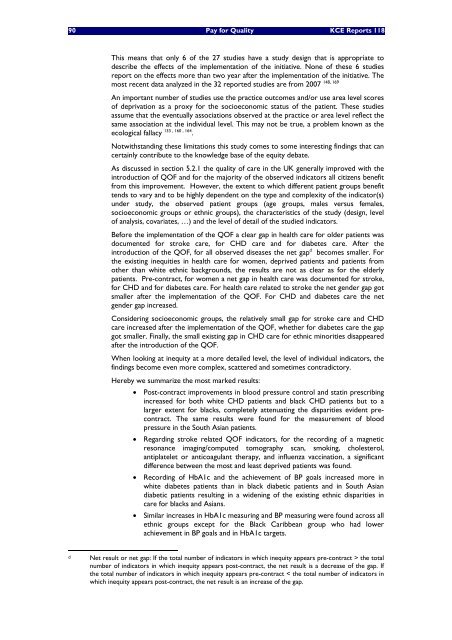Pay for Quality
Pay for Quality
Pay for Quality
Create successful ePaper yourself
Turn your PDF publications into a flip-book with our unique Google optimized e-Paper software.
90 <strong>Pay</strong> <strong>for</strong> <strong>Quality</strong> KCE Reports 118<br />
This means that only 6 of the 27 studies have a study design that is appropriate to<br />
describe the effects of the implementation of the initiative. None of these 6 studies<br />
report on the effects more than two year after the implementation of the initiative. The<br />
148, 169<br />
most recent data analyzed in the 32 reported studies are from 2007<br />
An important number of studies use the practice outcomes and/or use area level scores<br />
of deprivation as a proxy <strong>for</strong> the socioeconomic status of the patient. These studies<br />
assume that the eventually associations observed at the practice or area level reflect the<br />
same association at the individual level. This may not be true, a problem known as the<br />
ecological fallacy 133 , 160 , 164 .<br />
Notwithstanding these limitations this study comes to some interesting findings that can<br />
certainly contribute to the knowledge base of the equity debate.<br />
As discussed in section 5.2.1 the quality of care in the UK generally improved with the<br />
introduction of QOF and <strong>for</strong> the majority of the observed indicators all citizens benefit<br />
from this improvement. However, the extent to which different patient groups benefit<br />
tends to vary and to be highly dependent on the type and complexity of the indicator(s)<br />
under study, the observed patient groups (age groups, males versus females,<br />
socioeconomic groups or ethnic groups), the characteristics of the study (design, level<br />
of analysis, covariates, …) and the level of detail of the studied indicators.<br />
Be<strong>for</strong>e the implementation of the QOF a clear gap in health care <strong>for</strong> older patients was<br />
documented <strong>for</strong> stroke care, <strong>for</strong> CHD care and <strong>for</strong> diabetes care. After the<br />
introduction of the QOF, <strong>for</strong> all observed diseases the net gap d becomes smaller. For<br />
the existing inequities in health care <strong>for</strong> women, deprived patients and patients from<br />
other than white ethnic backgrounds, the results are not as clear as <strong>for</strong> the elderly<br />
patients. Pre-contract, <strong>for</strong> women a net gap in health care was documented <strong>for</strong> stroke,<br />
<strong>for</strong> CHD and <strong>for</strong> diabetes care. For health care related to stroke the net gender gap got<br />
smaller after the implementation of the QOF. For CHD and diabetes care the net<br />
gender gap increased.<br />
Considering socioeconomic groups, the relatively small gap <strong>for</strong> stroke care and CHD<br />
care increased after the implementation of the QOF, whether <strong>for</strong> diabetes care the gap<br />
got smaller. Finally, the small existing gap in CHD care <strong>for</strong> ethnic minorities disappeared<br />
after the introduction of the QOF.<br />
When looking at inequity at a more detailed level, the level of individual indicators, the<br />
findings become even more complex, scattered and sometimes contradictory.<br />
Hereby we summarize the most marked results:<br />
• Post-contract improvements in blood pressure control and statin prescribing<br />
increased <strong>for</strong> both white CHD patients and black CHD patients but to a<br />
larger extent <strong>for</strong> blacks, completely attenuating the disparities evident precontract.<br />
The same results were found <strong>for</strong> the measurement of blood<br />
pressure in the South Asian patients.<br />
• Regarding stroke related QOF indicators, <strong>for</strong> the recording of a magnetic<br />
resonance imaging/computed tomography scan, smoking, cholesterol,<br />
antiplatelet or anticoagulant therapy, and influenza vaccination, a significant<br />
difference between the most and least deprived patients was found.<br />
• Recording of HbA1c and the achievement of BP goals increased more in<br />
white diabetes patients than in black diabetic patients and in South Asian<br />
diabetic patients resulting in a widening of the existing ethnic disparities in<br />
care <strong>for</strong> blacks and Asians.<br />
• Similar increases in HbA1c measuring and BP measuring were found across all<br />
ethnic groups except <strong>for</strong> the Black Caribbean group who had lower<br />
achievement in BP goals and in HbA1c targets.<br />
d Net result or net gap: If the total number of indicators in which inequity appears pre-contract > the total<br />
number of indicators in which inequity appears post-contract, the net result is a decrease of the gap. If<br />
the total number of indicators in which inequity appears pre-contract < the total number of indicators in<br />
which inequity appears post-contract, the net result is an increase of the gap.
















